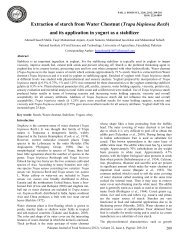(Zea mays. L) extrudates - PSFST
(Zea mays. L) extrudates - PSFST
(Zea mays. L) extrudates - PSFST
You also want an ePaper? Increase the reach of your titles
YUMPU automatically turns print PDFs into web optimized ePapers that Google loves.
weaning foods. Humans do not readily digest native<br />
starch. Distinct several thermal processes, extrusion<br />
cooking gelatinizes starch fairly low (12-22%) moisture<br />
level. Increased temperature of barrel, shear force and<br />
pressure in extrusion raise the level of gelatinization of<br />
starch, but lipids, sucrose, dietry fiber and salts can<br />
impede gelatinization (Jin t al, 1994). While full<br />
gelatinization may not occur through extrusion,<br />
digestibility is frequently enhanced (Wang, S et al, 1993).<br />
Extrusion may progress protein digestibility by<br />
denaturing proteins, revealing enzyme-accessible sites.<br />
Globally the snack food industry is fetching up<br />
bigger and more imperative every day. In the last ten<br />
years, revolution in way of living and eating habits have<br />
escort to an ongoing enhance in demand for snack foods.<br />
The way of snacking in various countries can be<br />
influenced by numerous aspects like as the diversity in<br />
lifestyle in every area, the economic conditions, and<br />
public accessibility of existing observation on nutritional<br />
subject. Snacks can supply a better dietary intake of<br />
essential amino acids and other food nutrients for<br />
developing countries. Extrusion cooking is preferable<br />
over other food-processing methods due to of constant<br />
process with high efficiency and important nutrient<br />
preservation, due to the high temperature and short<br />
cooking time required (Guy, 2001).<br />
There is a need to make use of locally-grown crops to<br />
produce of suitable local recipes in the under developed<br />
countries has been tense by international agencies as the<br />
most efficient channel for addressing depending world<br />
food harms (Iwe et a!. 2001). Maize is the cereal of major<br />
importance in the developing world and has the maximum<br />
genetic production potential of all the cereal crops.<br />
Designing extruded snack foods today can be a difficult<br />
process to meet up varying consumer’s tastes and<br />
demands. The consumer’s requirement for “good for your<br />
health” and “distinctive flavor” extruded snacks leads to<br />
the indefinable exploration for something exceptional that<br />
also demand to extensive range of peoples. Consequently<br />
the current study has been designed to investigate the<br />
effect of different extruder variables temperature, screw<br />
speed and moisture content on the chemical and mineral<br />
profile of two different maize cultivars.<br />
Materials and methods<br />
The current research was performed to determine<br />
the suitability of maize cultivars for extrusion cooking and<br />
effect of different extrusion parameters on quality of<br />
product. The study proposed in this manuscript was<br />
conducted at the “Extrusion Center”, National Institute of<br />
Food Science and Technology, University of Agriculture,<br />
Faisalabad.<br />
Pakistan Journal of Food Sciences (2012), Volume 22, Issue 2, Page(s): 108-116<br />
PAK. J. FOOD SCI., 22(2), 2012:108-116<br />
ISSN: 2226-5899<br />
Procurement of raw material<br />
Two commercial maize cultivars namely<br />
hybrid R-2303 yellow dent corn and R-2207 White<br />
flint corn were procured from Rafhan Maize<br />
Faisalabad.<br />
Cleaning<br />
Maize grains were cleaned physically to eliminate<br />
dust particles, broken seeds, seeds of other crops and<br />
other contaminants like as weeds and metals.<br />
Preparation of raw material<br />
Two commercial maize cultivars namely hybrid R-<br />
2303 yellow dent corn and R-2207 White flint corn were<br />
milled to obtain maize grits according to a milling<br />
diagram proposed by Robutti et al., (2002).<br />
Extrusion process<br />
The maize cultivars were extruded through a singlescrew,<br />
short barrel (90 mm) snack food extruder (Extru-<br />
Tech, Inc.Model # KN, Sabetha, Ks 66534). The extruder<br />
was fixed with a 2 start screw and a 2-hole die with 4mm<br />
orifice. The prepared raw material, maize grits were fed<br />
into the extruder at the rate of 20 Kg /h using a mass flow<br />
feeding device. The extruder was run at different barrel<br />
temperatures ranges between 110 and 150 °C. Energy<br />
consumption during extrusion differs among the grits<br />
extruded in the research. Extrusion cooking was initiate<br />
to be a high-temperature, short-time process in which<br />
moistened, extensive, starchy and protinacious food<br />
materials are plasticized and cooked in a tube by a<br />
permutation of moisture, pressure, temperature and<br />
mechanical shear .The plastic foam set quickly as it left<br />
the die, forming a light, crispy, firm material alike to<br />
various well recognized snack foods. As the <strong>extrudates</strong><br />
come out from the die, it was cut into 10–12 mm long<br />
snack-like <strong>extrudates</strong> with a revolving knife. Promising<br />
<strong>extrudates</strong> were instantly spread on the laboratory table at<br />
room temperature for 4 h before drying in the oven at 60<br />
°C for 10 h to attain a final moisture content of 4-5% and<br />
stored in plastic bags at room temperature for more<br />
analysis.<br />
Chemical analysis of maize grits and <strong>extrudates</strong><br />
Chemical analysis of maize grits and <strong>extrudates</strong><br />
were carried out by following the methods illustrated in<br />
(AACC, 2000).<br />
Moisture Content<br />
The moisture content in maize grits and grounded<br />
<strong>extrudates</strong> was estimated by drying samples in a hot air<br />
oven at a temperature of 100± 5 °C until to a constant<br />
weight. Moisture contents was determined by following<br />
the method no 44-15A of AACC (2000).<br />
The extruder variables applied in this study are given in<br />
Table1<br />
109




